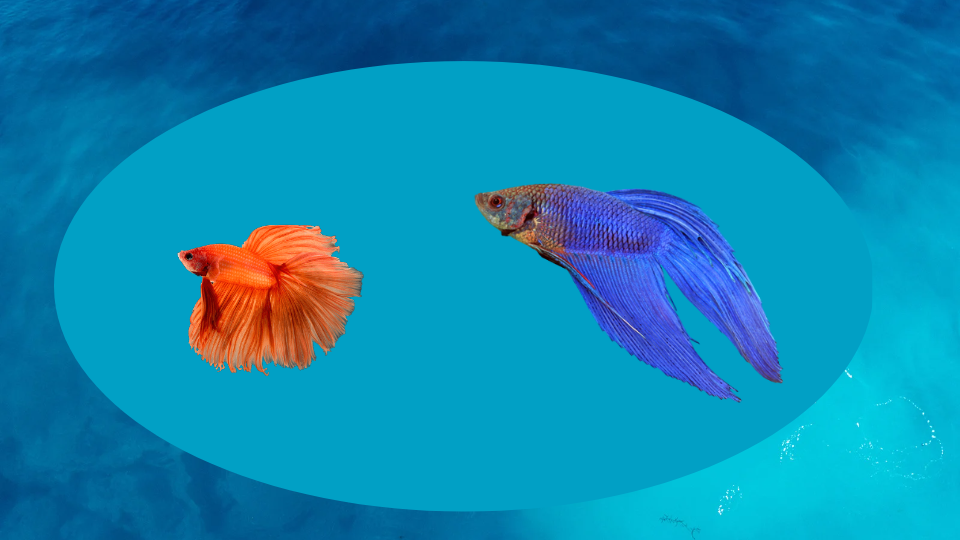How Big Can Betta Fish Get? How Fast Do Bettas Grow & How To Grow Larger?
Hi there, fish lover! Ever wonder how big your betta fish can get and how fast it can grow? Look no further. We’re spilling the beans in this post, and we’ll give you the secrets to bettas’ growth and how they reach their maximum size asap.
Don’t miss out! Once you know the secret factors that impact your little buddy’s growth, you can help it reach its full potential. Let’s dive in and answer all your burning questions and make you an expert betta owner capable of giving your fish the best life possible.
How Big Do Betta Fish Get: Domestic Betta Fish vs. Wild Bettas Size

Domestic betta fish are the types you will find in almost every home aquarium, and they are prevalent due to their unique color, patterns, small size, and aggressive behavior. On average, the domestic betta fish grow to about 2.5 inches or 6.35 cm in length, rarely bigger than 3 inches or 7.62 cm.
Their growth depends on several factors, such as their specific species, genetics, diet, and living conditions. Genetics is not something a fish owner can control, so naturally, some fish are smaller than others due to their DNA and expressed traits.
Food is another factor, as fish receiving a nutritious diet continuously while growing can grow faster in their infancy and grow longer, more prominent, fatter, and heavier. Also, keeping the water quality high improves the chances that the fish will be healthy and not have illness or disease, which can stump its growth.
Wild bettas live different lives than their domesticated cousins that live in captivity in small tanks worldwide. The wild bettas’ natural habitat is in Southeast Asia’s slow-moving rivers, canals, creeks, and rice paddies. In this environment, they tend to grow a bit larger than the domestic species, reaching up to 3 inches or 7.62 cm in length, but there are more than 70 different species of wild betta, so it varies.
Growth Timeline: How Fast do Bettas Grow? Baby Betta Fish to Full Size

Betta growth is rapid, with fry reaching about 1.9 inches in just eleven weeks. At the beginning of this timeline, betta eggs are only about 0.03 inches in diameter. One day after hatching, fry are already 0.1 inches long but still so small that you can’t even see their tail.
By one week old, fry has grown to 0.2 inches; at two weeks old, they are 0.25 inches long and starting to show their dorsal fin. By three weeks old, the fry are 0.35 inches long; at four weeks old, they have reached 0.45 inches.
After five weeks, fry are 0.6 inches long; at six weeks old, they have grown to 0.85 inches. Seven weeks old fry are 1.1 inches, and at eight weeks old, they are 1.3 inches. Nine weeks old fry are 1.55 inches long, ten weeks old fry are 1.7 inches, and eleven weeks old, they have grown to 1.9 inches.
Keep a ruler handy to track your betta’s growth and ensure they are on track! If their growth is off by 15-20%, either smaller or larger, don’t worry, as the listed numbers are just averages. After this rapid growth stage, their growth starts to slow down, and around 7 months old, they are fully grown into adult betta splendens.
Factors That Affect Betta Fish Growth

Betta fish are known for their rapid growth, with some individuals reaching their full size in as little as six months with proper care. However, several factors can impact a betta fish’s growth rate, including diet, living conditions, and genetics.
A balanced, nutritious diet is crucial for proper betta fish growth, as is a clean, properly-sized tank with the appropriate water temperature, pH, and filtration. Genetics can also play a role, with some betta fish naturally growing faster or slower due to their inherited traits.
You can help your betta reach its full potential by providing a suitable living environment and a varied and nutritious diet. Avoid overfeeding, which can lead to health problems and slower growth.
The difference in Size Between Species and Male and Female Betta Fish

Male vs. Female
There is often a difference between males and females. Female betta fish tend to be smaller than males, typically reaching a size of about 2.25 inches. On the other hand, adult male bettas can grow up to 2.6 inches.
Giant Betta Fish (Betta Anabontoides) Size
Giant betta fish, also known as betta anabatoides, result from consistently breeding the biggest males and females. This species is twice as big as the average betta, reaching a size of up to 5 inches or 12.7 cm in length, and are the biggest in the family of betta species.
Despite their size, giant bettas can finish a meal in just 45 seconds, which is enough food for a single day. The rest of the time, these fish can swim around their tank, hang out with tank friends (if they get along), or relax in hiding spots.
King Betta Size
King betta males typically grow to about 5-6 cm (2-2.5 inches) and display vibrant beige to white pigments. These fish are a bit shorter-lived than other betta species, with a lifespan of only 2-3 years, although some may reach four years with proper care. They prefer a warm water temperature of 78-82°F and can be fed various foods, including fish flakes, pellets, bloodworms, and freeze-dried brine shrimp.
When setting up a tank for king bettas, it’s crucial to provide a natural environment with dim lighting, aquatic vegetation, floating plants, an air-powered sponge filter, and a covered tank to prevent jumps. Additionally, adding dry leaves and driftwood roots or branches can help provide shade and serve as a supplementary food source when decomposed.
The Peaceful betta, Crescent Betta, or Betta Imbellis Size
The peaceful betta or crescent betta, Betta imbellis, is native to Southeast Asia, where it occurs naturally in Southern Thailand, Malaysia, and Indonesia and has been introduced to Singapore. It is an inhabitant of stagnant waters in swamps, rice paddies, ditches, and pools. This species grows to a length of 6 cm (2.4 in). It is also found in the aquarium trade.
How to Make Your Betta Fish Grow Bigger and Faster

While betta fish are relatively fast growers, there are steps you can take to help them reach their full size more quickly:
Providing a suitable living environment with proper water conditions and a spacious tank, offering a varied, nutritious diet including live or frozen foods, as well as pellets or flakes, and avoiding overfeeding can all help your betta fish grow faster. It’s important to remember that betta fish are living creatures, and it’s crucial to prioritize their health and well-being over their growth rate.
Frequently Asked Questions
What is the average size of betta fish?
The average size of a betta fish can vary depending on the species and environment, but domestic betta fish are typically about 2.5 inches (6.35 cm) in length, while wild betta fish tend to be slightly larger at about 3 inches (7.62 cm). Male bettas are generally larger than females, with an average size of about 3 inches (7.62 cm) for males and 2.5 inches (6.35 cm) for females.
How long does it take for betta to grow to full size?
Betta fish are relatively fast growers and can reach their full size in as little as 6 months with proper care. Factors that can impact betta fish growth rate include diet, living conditions, and genetics.
What can I do to help my betta fish grow?
To help your betta fish grow to its full size potential, you should provide a suitable living environment with proper water conditions and a spacious tank. Offer a varied, nutritious diet including live or frozen foods, as well as pellets or flakes, and avoid overfeeding, which can lead to health problems and slower growth.
Is it normal for my betta fish to be smaller than average?
It’s not uncommon for betta fish to be smaller or larger than average due to genetics and other factors. If your betta fish is healthy and receiving proper care, it is likely growing at a normal rate for its individual size and genetics.
Can I make my betta fish grow faster?
While betta fish are relatively fast growers, it’s important to prioritize their health and well-being over their growth rate. To help your betta fish grow faster, you can provide a suitable living environment with proper water conditions and a spacious tank, offer a varied, nutritious diet including live or frozen foods, and avoid overfeeding. It’s also important to remember that there may be limits to how fast your betta fish can grow based on its individual genetics and other factors.

